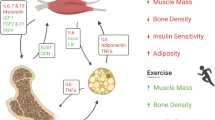Abstract
Nuclear peroxisome proliferator-activated receptor γ (PPARγ) is the target of antidiabetogenic thiazolidinediones (TZD). However, recent studies failed to show that TZD has an effect in vitro on insulin-regulated glucose uptake in skeletal muscles, the major site of glucose disposal. The potential effects of TZD on cells adjacent to skeletal muscles are not well characterized but may be involved in TZD's actions. Hence, we studied these cells from mice treated with the carrier and with the TZD ciglitazone (9 nmol/g body weight). The cells were typified by lipid enrichment (floating adipocytes and macrophages), by the ectopic expression of cellular fibronectin (fibroblasts), fibronectin and PPARγ (preadipocytes), PPARγ and CD11b/Mac-1 (active macrophages) as revealed by flow cytometry and immunoblotting. The glucose transporter 4 proteins (GLUT4) and the uptake of glucose and long-chain fatty acids (LCFA) were determined flow cytometrically using fluorescent derivatives of glucose (NBDG) and LCFA (C16-Bodipy). The expression of tumor necrosis factor α (TNFα) in CD11b/Mac-1-positive and CD11b/Mac-1-negative cells separated by magnetic immunobeads was analyzed. The results showed that TZD treatment upregulated GLUT4 expression, and increased insulin-regulated NBDG uptake and C16-Bodipy binding and influx, at the same time as increasing the quantity of PPARγ-expressing fibroblasts; this indicates the development of the preadipocyte phenotype. In contrast, TZD lowered the number of adipocytes (0.6-fold compared to the carrier-treated control) perhaps through an action of TNFα from CD11b- and PPARγ-expressing macrophages. The data suggest that the regulatory effects of TZD on energy homeostasis involve two major targets: the PPARγ-positive fibroblasts whose adipogenic program is promoted, and CD11b-PPARγ-expressing macrophages which become cytotoxic and fibrogenic because of the effects of TNFα on neighboring adipocytes and fibroblasts, respectively.
Similar content being viewed by others

Author information
Authors and Affiliations
Additional information
Received after revision: 16 September 1999
Electronic Publication
Rights and permissions
About this article
Cite this article
Löhrke, B., Shahi, S., Krüger, B. et al. Thiazolidinedione-induced activation of the transcription factor peroxisome proliferator-activated receptor γ in cells adjacent to the murine skeletal muscle: implications for fibroblast functions. Pflügers Arch – Eur J Physiol 439, 288–296 (2000). https://doi.org/10.1007/s004249900174
Received:
Accepted:
Published:
Issue Date:
DOI: https://doi.org/10.1007/s004249900174



